- 2 H2SO4
 H3SO+ 4 + HSO− 4
H3SO+ 4 + HSO− 4 - Kap(25°C)= [H3SO+ 4][HSO− 4] = 2.7×10−4.
- Sulfides are moderately strong reducing agents. They react with oxygen in the air in elevated temperatures to form higher-valence sulfur salts, such as sulfates and sulfur dioxide.
- When adding all the digits in a single row, each successive row has twice the value of the row preceding it. For example, row 1 has a value of 1, row 2 has a value of 2, row 3 has a value of 4, and so forth.
- The value of a row, if each entry is considered a decimal place (and numbers larger than 9 carried over accordingly) is a power of 11 ( 11n, for row n). Thus, in row two, '1,2,1' becomes 112, while '1,5,10,10,5,1' in row six becomes (after carrying) 161,051, which is 115. This property is explained by setting x = '10' in the binomial expansion of (x + 1)row=n, and adjusting values to the decimal system. But x can be chosen to allow rows to represent values in any base - such as base 3; 1 2 13['1,2,1'] = 42 (16), 2 1 0 13 ['1,3,3,1'] = 43 (64) - or base 9; 1 2 19 = 102 (100), 1 3 3 19 = 103 (1000) and 1 6 2 1 5 19 ['1,5,10,10,5,1'] = 105 (100,000). In particular (see next property), for x = 1 place value remains constant(1place=1). Thus entries can simply be added in interpreting the value of a row.
- The sum of the elements of row m is equal to 2m−1. For example, the sum of the elements of row 5 is 1 + 4 + 6 + 4 + 1 = 16, which is equal to 24 = 16. This follows from the binomial theorem proved above, applied to (1 + 1)m−1.
- If rows are numbered starting with n = 0, the sum of the elements in the row is simply 2n, so row 0 adds to 20 = 1, row 1 adds to 21 = 2, etc.
- Some of the numbers in Pascal's triangle correlate to numbers in Lozanić's triangle.
- The sum of the squares of the elements of row m equals the middle element of row (2m − 1). For example, 12 + 42 + 62 + 42 + 12 = 70. In general form:
-
- Another interesting pattern is that on any row m, wherem is odd, the middle term minus the term two spots to the left equals a Catalan number, specifically the (m + 1)/2 Catalan number. For example: on row 5, 6 − 1 = 5, which is the 3rd Catalan number, and (5 + 1)/2 = 3.
- Another interesting property of Pascal's triangle is that in rows where the second number (immediately following '1') is prime, all the terms in that row except the 1s are multiples of that prime.
SULPHUR, GIZA PYRAMIDS, THE PHILOSOPHER STONE, SACRED GEOMETRY, KNIGHT TEMPLARS, FREEMASONERY, 4 TH DIMENSION, THE UNDERWORLD OR THE SAME HELL
Christian Ronsenkreuz SHHH TOP SECRET |
V.I.T.R.I.O.L (Masonic/Alchemical Motto)
The alchemical motto for vitriol is “Visita Interiora Terrae Rectificando Invenies Occultum Lapidem,” “Visit the interior of the earth and rectifying (purifying) you will find the hidden stone.” The motto originated in L’Azoth des Philosophes by the 15th Century alchemist Basilius Valentinus.
Sulfuric acid (alternative spelling sulphuric acid) is a strong mineral acid with the molecular formula H2SO4. Its historical name is vitriol. The salts of sulfuric acid are calledsulfates. Sulfuric acid is soluble in water at all concentrations.
Sulfuric acid has many applications, and is a central substance in the chemical industry. Principal uses include lead-acid batteries for cars and other vehicles, ore processing,fertilizer manufacturing, oil refining,wastewater processing, and chemical synthesis.
Pure sulfuric acid is not encountered naturally on Earth, due to its great affinity for water. Apart from that, sulfuric acid is a constituent of acid rain, which is formed by atmosphericoxidation of sulfur dioxide in the presence of water – i.e., oxidation of sulfurous acid. Sulfur dioxide is the main byproduct produced when sulfur-containing fuels such as coal or oil are burned.
Polarity and conductivity
Anhydrous H2SO4 is a very polar liquid, having a dielectric constant of around 100. It has a high electrical conductivity, caused by dissociation through protonating itself, a process known as autoprotolysis.[4]
The equilibrium constant for the autoprotolysis is[4]
The comparable equilibrium constant for water, Kw is 10−14, a factor of 1010 (10 billion) smaller.
In spite of the viscosity of the acid, the effective conductivities of the H3SO+
4 and HSO−
4 ions are high due to an intra-molecular proton-switch mechanism (analogous to the Grotthuss mechanism in water), making sulfuric acid a good conductor. It is also an excellent solvent for many reactions.
4 and HSO−
4 ions are high due to an intra-molecular proton-switch mechanism (analogous to the Grotthuss mechanism in water), making sulfuric acid a good conductor. It is also an excellent solvent for many reactions.
Jupiter and other thunder gods such as Hercules, Zeus, Duir,
Janus, Thor, Bel, and Hermes are all oak-gods.
Yahweh in his aspects of El or Jah, which are interchangeable terms, is also an Oak-god. The Roman poet Virgil, who lived from 70BCE to 17BCE, mentions the roots
of the Oak tree. He says they run as deeply into the ground as the
branches rise to heaven. The oak is therefore highly reminiscent of the
fundamental hermetic maxim as above, so below. In the dimension of
time, the oak stands at the turn of the year.
The Oak tree therefore symbolizes the annual resurrection god who rules Heaven and the
Underworld, the ram-headed god Osiris, Hercules and all immortal gods,
particularly Amun-Ra.
The faerie Queen Cantos ( Elizabeth I ) |
The red gem symbolizing the hidden stone known as carmot
Sulphuric acid from Volcano |
Laetiporus sulphureus from an oak is a species of bracket fungus (fungus which grows on trees) found in Europe and North America. Its common names are sulphur polypore,sulphur shelf, and chicken mushroom. Its fruiting bodies grow as striking golden-yellow shelf-like structures on tree trunks and branches. |
French revolution Phrygian cup |
Organic chemistry
In organic chemistry, "sulfide" usually refers to the linkage C-S-C, although the termthioether is less ambiguous. For example, the thioether dimethyl sulfide is CH3-S-CH3.Polyphenylene sulfide (see below) has the empirical formula C6H4S. Occasionally, the term sulfide refers to molecules containing the -SH functional group. For example, methyl sulfide can mean CH3-SH. The preferred descriptor for such SH-containing compounds is thiol or mercaptan, i.e. methanethiol, or methyl mercaptan.
Mer-thiol-ate or Thiomerosal ( mercury captor ) the cause of autism, alzheimer, Parkinson and other diseases thanks to the Luciferian Eugenics policies. |
A sulfide is an anion of sulfur in its lowest oxidation state of −2. Sulfide is also a slightly archaic term for thioethers, a common type of organosulfur compound that are well known for their bad odors.
"The ancient symbol of the Orphic Mysteries was the serpent-entwined egg, which signified Cosmos as encircled by the fiery Creative Spirit. The egg also represents the soul of the philosopher; the serpent, the Mysteries. At the time of initiation the shell is broke. and man emerges from the embryonic state of physical existence wherein he had remained through the fetal period of philosophic regeneration." (Manly P. Hall)
Protein and organic cofactors of Sulfur
In plants and animals, the amino acids cysteine and methionine contain most of the sulfur. The element is thus present in all polypeptides, proteins, and enzymes that contain these amino acids. Disulfide bonds (S-S bonds) formed between cysteine residues in peptide chains are very important in protein assembly and structure. These covalent bonds between peptide chains confer extra toughness and rigidity.[47] For example, the high strength of feathers and hair is in part due to their high content of S-S bonds and their high content of cysteine and sulfur. Eggs are high in sulfur because large amounts of the element are necessary for feather formation, and the characteristic odor of rotting eggs is due to hydrogen sulfide. The high disulfide bond content of hair and feathers contributes to their indigestibility, and also to their characteristic disagreeable odor when burned.
Good actor he works for the illuminati the CIA put him in charge remember left illusion and the double headed eagle of Freemasonery ancient Babylonian, Machiavellian tactics. He finances the Colombian Guerrilla for supporting the Narcos at the same time wires laundered money for South American corrupt Presidents in private Jets ( Antonini and Pedevesa Argentina Kirchner case ) |
Venezuela´s name comes also from Venus as Venice, the colour of the flag encrypts
the basic colours of sulphur state after burning, yellow, red and the blue flame.
Simon Bolivar and the Jahbulon
Simón José Antonio de la Santísima Trinidad Bolívar y Palacios Ponte y Blanco, commonly known as Simón Bolívar (Spanish pronunciation: [siˈmon boˈliβar]; July 24, 1783 – December 17, 1830) was a Venezuelan military and political leader. Together with José de San Martín, he played a key role in Latin America's successful struggle for independence from the Spanish Empire.
Jahbulon
Jah : Yahve Bul
Bul = Baal
On = Osiris
Semitic, Canaanite child sacrifice to the God Baal
Polarity and conductivity
The di anion S2− exists only in strongly alkaline aqueous solutions. Such solutions can form by dissolution of H2S or alkali metal salts such as Li2S, Na2S, and K2S in the presence of extra hydroxide. The ion S2− is exceptionally basic with a pKa > 14. It does not exist in appreciable concentrations even in highly alkaline water, being undetectable at pH < ~15 (8 M NaOH).[1]
Instead, sulfide combines with protons to form HS−, which is variously called hydrogen sulfide ion, hydrosulfide ion,sulfhydryl ion, or bisulfide ion. At still lower pH's (<7), HS−converts to H2S, hydrogen sulfide.[2]
Organic Chemistry
In organic chemistry, "sulfide" usually refers to the linkage C-S-C, although the termthioether is less ambiguous. For example, the thioether dimethyl sulfide is CH3-S-CH3.Polyphenylene sulfide (see below) has the empirical formula C6H4S. Occasionally, the term sulfide refers to molecules containing the -SH functional group. For example, methyl sulfide can mean CH3-SH. The preferred descriptor for such SH-containing compounds is thiol or mercaptan, i.e. methanethiol, or methyl mercaptan.
Disulfides
Confusion arises from the different meanings of the term "disulfide". Molybdenum disulfide(MoS2) consists of separated sulfide centers, in association with molybdenum in the formal 4+ oxidation state (Mo4+). Iron disulfide (pyrite, FeS2) on the other hand consists of S22−, or−S–S− dianion, in association with divalent iron in the formal 2+ oxidation state (ferrous ion: Fe2+). Dimethyldisulfide has the chemical binding CH3-S–S-CH3, whereas carbon disulfidehas no S–S bond, being S=C=S (linear molecule analog to CO2). Most often in sulfur chemistry and in biochemistry, the disulfide term is commonly ascribed to the sulfur analogue of the peroxide −O–O− bond. The disulfide bond (−S–S−) plays a major role in the conformation of proteins and in the catalytic activity of enzymes.
Examples :
H2S Hydrogen sulfide is a very toxic and corrosive gas characterised by a typical odour of "rotten egg".
Na2S Sodium sulfide is an important industrial chemical, used in manufacture of kraft paper, dyes, leather tanning, crude petroleum processing, treatment of heavy metal pollution, and others.
Examples :
H2S | Hydrogen sulfide is a very toxic and corrosive gas characterised by a typical odour of "rotten egg". |
Na2S | Sodium sulfide is an important industrial chemical, used in manufacture of kraft paper, dyes, leather tanning, crude petroleum processing, treatment of heavy metal pollution, and others. |
Zinc sulfide |
ZnS | Zinc sulfide is used for lenses and other opticaldevices in the infrared part of the spectrum. Zinc sulfide doped with silver is used in alpha detectors while zinc sulfide with traces of copper has applications in photoluminescent strips for emergency lighting and luminous watch dials. |
Note zinc sulfide and traces of copper the key for pineal gland enlightenment
Zinc and Alexander Seton Alchemist
In the lives of the various alchemists, we find many notices of the philosophers' stone in connection with those adepts who were supposed to have arrived at the solution. Thus in the story of Alexander Seton, a Scotsman who came from Port Seton, near Edinburgh, it is stated that on his various travels on the continent he employed in his alchemical experiments a black-ish powder, the application of which turned any metal given him into gold.
Numerous instances are on record of Seton's projections, the majority of which were verified by multiple observers. On one occasion, while in Holland, he went with some friends from the house at which he was residing to undertake an alchemical experiment at another house near by. On the way there, a quantity of ordinary zinc was purchased, and reportedly Seton succeeded in projecting the zinc into pure gold by the application of his powder. A similar phenomenon occurred at Cologne, and even the most extreme torture could not wring the secret from him.
Seton's pupil or assistant, Sendivogius, made great efforts to obtain the secret from Seton before he died, but without success. However, out of gratitude Seton bequeathed him what remained of his marvelous powder, which Sendivogius employed with the same results Seton had achieved.
The answer to David G. Stephenson question :
A voyage into the past, borne by sails full bellied with the life-giving monsoon winds to the mystic east, has brought us to the goal of the alchemists. The ultimate fount of wealth and cosmic wisdom is finally revealed as nothing more than metallic zinc; mundane, cheap, dull, gray zinc! Did the ancient scholars dedicate their lives to so unworthy a purpose?
Romancing the Philosopher’s Stone
January 2006 Approx. 5100 words
David G. Stephenson
If our traveler was an honored guest, he may have been ushered into the holy precincts of a Hindu temple, there to see an image of a Hindu god crafted from the Five Metals. “The Five Metals” it is a phrase still uttered with reverence today, for it is an alloy of base metals, enriched by the noble metal itself, that has the color, lustre and some of the heft of gold. Let our traveler persist, and no doubt with the exchange of a little real gold, and eventually into his hand might pour a stream of flakes of a strange, crumbly, gray metal; the Philosopher’s Stone: pure, elemental, Zinc!
Brass is an alloy of copper and zinc. All the metals of antiquity were smelted by heating the ore in a charcoal furnace. Metal ores are either metallic sulphides or oxides, and a sulphide ore can be converted to the oxide by heating it in the air. Charcoal is pure carbon, and in the air burns to carbon dioxide. At the heart of a furnace the reaction is incomplete and the carbon becomes hot carbon monoxide gas. This rips oxygen from the ore and the resulting carbon dioxide escapes leaving the metal behind. The first metals, copper and tin are released as liquids and form a pool at the bottom of the furnace. The temperatures in a primitive charcoal furnace are not high enough to melt iron, so iron is liberated as a spongy solid mass, called a bloom.
Sphallerite is Zinc Sulphide ore, and when heated in air becomes a white zinc oxide ash. The temperature at the heart of a charcoal furnace can readily exceed 950 degrees Celsius. At this temperature carbon monoxide reduces the ore to metal. Unfortunately zinc vaporizes at 915 degrees Celsius and is released as a gas and mixes with carbon dioxide simply escapes up the chimney. The Cementation process mixes charcoal with zinc oxide, air and copper in a hot, sealed crucible. The charcoal burns to carbon monoxide and releases the zinc as a gas. With nowhere else to go the zinc diffuses into the copper making brass. If the hot crucible is broken, the zinc vapor escapes and burns back to a white smoke of zinc oxide.
VENUS, THE GODDESS IN ALCHEMY IS COPPER
WOMAN HAVE MORE COPPER IN SERUM, HORMONES, SEX OESTROGENS AND COPPER, NATURAL MEDIUMS, COURTESANS, SACRED WHORES, HIGH PRIESTESS, WITCHES, BACCHANALS, ORPHIC - EULESIAN MYSTERIES, DYONISOS, PERSEPHONE, BABYLON, CALIGULA, ORGIES, ETC.
The statue of the prison made from copper |
MELATONIN FORTE - niacin, melatonin, nadide, pyridoxine hydrochloride, zinc sulfate heptahydrate, sus scrofa hypothalamus, lithium carbonate, magnesium carbonate, sus scrofa pineal gland and sus scrofa pituitary gland spray
Apotheca Company
----------
ACTIVE INGREDIENTS: Niacin 3X, Melatonin 6X, Nadidum 6X, Pyridoxinum hydrochloricum 6X, Zincum sulphuricum 6X, Hypothalamus 8X, Lithium carbonicum 89X, Magnesia carbonica 8X, Pineal 8X, Pituitary 8X.
INDICATIONS: For temporary relief of imbalances in menstruation and ovulation, insomnia, dysmenorrhea and imbalance in menstrual cycle.
WARNINGS: If pregnant or breast-feeding, ask a health care professional before use.
Note : melatonine metabolised on to a sulfate molecule
Recent research indicates that the first metabolite of melatonin in the melatonin antioxidant pathway may be N(1)-acetyl-N(2)-formyl-5-methoxykynuramine (or AFMK) rather than the common, excreted 6-hydroxymelatonin sulfate. AFMK alone is detectable in unicellular organisms and metazoans. A single AFMK molecule can neutralize up to 10 ROS/RNS(reactive oxygen species/reactive nitrogen species) since many of the products of the reaction/derivatives (including melatonin) are themselves antioxidants. This capacity to absorb free radicals extends at least to the quaternary metabolites of melatonin, a process referred to as "the free radical scavenging cascade". This is not true of other, conventional antioxidants.
The Chamaleon and melatonin : Dragon codes
Melatonin is related to the mechanism by which some amphibians and reptiles change the color of their skin and, indeed, it was in this connection the substance first was discovered.[16][17] As early as 1917, McCord and Allen discovered (J Exptl Zool, 1917) that extract of the pineal glands of cows lightened frog skin.
 |
| Trilateral Comission seal |
 |
| The whore of Babylon and the Holy Grail |
Glowing mushrooms |
The Goddess Cybele comanding the French Revolution |
REALLY ?
THE AGE OF LUCIFER
In chemistry, vitriol is iron or copper sulfate salts and their derivative, sulfuric acid. The name comes from the Latin for “glassy,” after the resemblance of iron sulfate to shards of green glass. Vitriol is symbolized alchemically as the “green lion,” a poisonous substance that appears when metal is degraded by acid. Sulfuric acid, or oil of vitriol, was used in the synthesis of the lapis philosophorum- the Philosopher’s Stone. One unique property of sulfuric acid is the dissolution of metals- all except for gold, on which it has no effect.
Iron sulfate |
Green Lion through fire purification we obtain the red Lion |
Occurrence : Sulphur occurs in free state in many parts of world and has been known since prehistoric times.
The name sulphur is derived from the Sanskrit name 'Shulbary' meaning enemy of copper (Sulphur was known in ancient time to destroy the metallic property of copper). Deposits of free elemental sulphur occur in areas of volcanic activity. The natural sources of occurrence of sulphur in combined state are (i) H2S in sour natural gas and organic compounds containing sulphur in crude oil, (ii) pyrite (FeS2) and other metal sulphide minerals and (iii) sulphate minerals like gypsum (CaS04). Sulphur : The Element
Sulphur (S) is a non metal belonging to the VIA group / group 16 and the 3rd period in the p-block of periodic table. It is placed below oxygen. The atomic number of sulphur is 16 with electronic configuration (2,8,6). The atomic mass of sulphur is 32. lu. Sulphur shows a variable valency of 2,4 and 6 (e.g. H2S, S02, SO3 are the compounds of sulphur).
Properties of Sulphur : Physical Properties :Sulpur is a non- metallic, brittle, yellow solid. It is insoluble in water but dissolves in organic solvents such as carbon disulphide, methyl benzene. It is a bad conductor of electricity in solid, molten and dissolved state.
Allotropes of Sulphur: Sulphur exists in two crystalline solid forms, rhombic sulphur and inonoclinic sulphur The property by which an element exists in two or more forms is called allotropy. Different forms of element are known as allotropes. The allotrope rhombic sulphur is stable at temperatures below 94.5°C. Therefore, sulphur is normally found in this form. When rhombic sulphur is heated to 94.5°C if is transformed into the other allotrope called monoclinic sulphur. Monoclinic sulphur is stable between 94.5°C to 120°C. If monoclinic sulphur is cooled it transforms into rhombic sulphur at 94.5°C. The shapes of rhombic and monoclinic sulphur are shown in Fig. 1.4.
Rhombic sulfur and the unfinished pyramid |
When molten sulphur is cooled, it solidifies into monoclinic sulphur. Sublimate of sulphur is called 'flower of sulphur'. When sulphur is obtained by a chemical reaction as precipitate it is called 'milk of sulphur'. These are made up of rhombic sulphur. Scientists have discovered many more allotropes of sulphur under different conditions.
All of them get transformed into rhombic sulphur at room temperature.
Kether the Crown of the Kabbalah |
Sulphur has catenating power. It forms strong S-S covalent bonds. This results in formation of Sg molecules. Sg molecules have a shape of a crown like ring (Fig. 1.5). Both, rhombic and monoclinic sulphur contain S8 rings. At high temperatures smaller molecules like Sg, S4, S2, S also exist.
Sulfur or sulphur ( /ˈsʌlfər/ SUL-fər; see spelling below) is the chemical elementwith atomic number 16, represented by the symbol S. It is an abundant, multivalentnon-metal. At normal conditions, sulfur atoms form cyclic octatomic molecules with chemical formula S8. Elemental sulfur is a bright yellow crystalline solid. Chemically, sulfur can react as either an oxidant orreducing agent. It oxidizes most metals and several nonmetals, including carbon, which leads to its negatives charge in mostorganosulfur compounds, but it reduces several strong oxidants, such as oxygenand fluorine.
/ˈsʌlfər/ SUL-fər; see spelling below) is the chemical elementwith atomic number 16, represented by the symbol S. It is an abundant, multivalentnon-metal. At normal conditions, sulfur atoms form cyclic octatomic molecules with chemical formula S8. Elemental sulfur is a bright yellow crystalline solid. Chemically, sulfur can react as either an oxidant orreducing agent. It oxidizes most metals and several nonmetals, including carbon, which leads to its negatives charge in mostorganosulfur compounds, but it reduces several strong oxidants, such as oxygenand fluorine.
In nature, sulfur can be found as the pure element and as sulfide and sulfate minerals. Elemental sulfur crystals are commonly sought after by mineral collectors for their brightly colored polyhedron shapes. Being abundant in native form, sulfur was known in ancient times, mentioned for its uses inancient Greece, China and Egypt.
St Peters Square Vatican octagonal division |
Mount temple top view |
Mount temple fron view |
Knight templar Temple Church |
Note : Circle divided into 8 and 33 with the roman imperial laurel |
Spanish Knight Templar Romanic Octagonal Church San Pedro de Cervates
Bacchanalia by Pierre Paul Rubens |
In ancient Greek religion, an orgion (ὄργιον, more commonly in the plural orgia) was an ecstatic form of worship characteristic of some mystery cults.[1] The orgion is in particular a cult ceremony of Dionysos, celebrated widely in Arcadia, featuring "unrestrained" masked dances by torchlight and animal sacrifice by means of random slashing that evoked the god's own rending and suffering at the hands of the Titans.[2] The orgia that explained the role of the Titans in Dionysos's dismemberment were said to have been composed by Onomacritus.[3] Greek art and literature, as well as some patristic texts, indicate that the orgia involved snake handling.[4]
Orgia may have been earlier manifestations of cult than the formal mysteries, as suggested by the violently ecstatic rites described in myth as celebrated by Attis in honor of Cybele and reflected in the willing self-castration of her priests the Galli in the historical period. The orgia of both Dionysian worship and the cult of Cybele aim at breaking down barriers between the celebrants and the divinity through a state of mystic exaltation:[5]
Goddess Cybele in Madrid
” |
Members of a group devoted to performing orgia are called orgeônes, whose activities were regulated by law. The cult of the Thracian goddess Bendis was organized at Athens by her orgeônes as early as the Archaic period.[8]
The participation of women in orgia, which in some manifestations was exclusive to women, sometimes led to prurient speculation and attempts to suppress the rites. In 186 BC, the Roman senate tried to ban Dionysian religion as subversive both morally and politically.[9]
Isidore of Seville says that the Latin equivalent of orgia was caerimoniae (English "ceremonies"), the arcane rites of ancient Roman religion preserved by the various colleges of priests
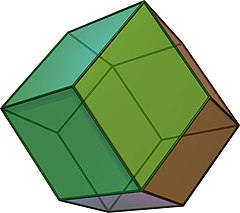
The rhombic dodecahedron can be used to tessellate 3-dimensional space. It can be stacked to fill a space much like hexagons fill a plane.
This tessellation can be seen as the Voronoi tessellation of theface-centred cubic lattice. Some minerals such as garnet form a rhombic dodecahedral crystal habit. Honeybees use the geometry of rhombic dodecahedra to form honeycomb from a tessellation of cells each of which is a hexagonal prism capped with half a rhombic dodecahedron. The rhombic dodecahedron also appears in the unit cells of diamond and diamondoids. In these cases, four vertices are absent, but the chemical bonds lie on the remaining edges
Honey comb
The rhombic dodecahedron can tessellate space by translational copies of itself:
Copper sulfate crystal |
The rhombic dodecahedron forms the hull of the vertex-first projection of a tesseract to 3 dimensions. There are exactly two ways of decomposing a rhombic dodecahedron into 4 congruent parallelepipeds, giving 8 possible parallelepipeds. The 8 cells of the tesseract under this projection map precisely to these 8 parallelepipeds.
The rhombic dodecahedron forms the maximal cross-section of a 24-cell, and also forms the hull of its vertex-first parallel projection into 3 dimensions. The rhombic dodecahedron can be decomposed into 6 congruent (but non-regular) square dipyramids meeting at a single vertex in the center; these form the images of 6 pairs of the 24-cell's octahedral cells. The remaining 12 octahedral cells project onto the faces of the rhombic dodecahedron. The non-regularity of these images are due to projective distortion; the facets of the 24-cell are regular octahedra in 4-space.
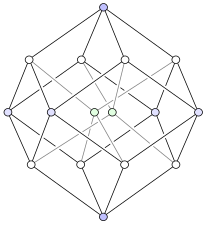
This decomposition gives an interesting method for constructing the rhombic dodecahedron: cut a cube into 6 congruent square pyramids, and attach them to the faces of a second cube. The triangular faces of each pair of adjacent pyramids lie on the same plane, and so merge into rhombuses. The 24-cell may also be constructed in an analogous way using two tesseracts.
The tesseract represents 4 th dimension and is the projection or shadow of the rhombic dodecahedron
 |
A 3D projection of an 8-cell performing a double rotation about two orthogonal planes |
Tesseract Hypercube Shadow or proyection |
8 pointed star and Goddess Ishtar |
The tesseract can be unfolded into eight cubes, just as the cube can be unfolded into six squares (view animation). An unfolding of a polytope is called a net. There are 261 distinct nets of the tesseract.[1] The unfoldings of the tesseract can be counted by mapping the nets to paired trees (a treetogether with a perfect matching in itscomplement). The forbidden apple The pentagonal rose ( Rosicrucians ) or the shewbread of Amun the mana of the Jews Triangular offering to Anubis ( Note golden triangle of pentagram ) The sothic triangle always depicted together with the ankh which is are the keys of the 4D mystery. |
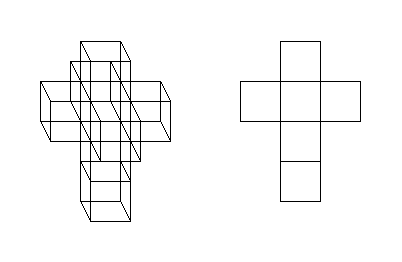
La Grande Arche de la Défense (also La Grande Arche de la Fraternité) is amonument and building in the business district of La Défense and in the commune ofPuteaux, to the west of Paris, France. It is usually known as the Arche de la Défenseor simply as La Grande Arche. The Arche is almost a perfect cube (width: 108m, height: 110m, depth: 112m); it has been suggested that the structure looks like a four-dimensional hypercube (a tesseract) projected onto the three-dimensional world. It has aprestressed concrete frame covered with glassand Carrara marble from Italy and was built by the French civil engineering company Bouygues. |

Sulphur Spectrum encrypted
Sulphur Spectrum
Crucifixion (Corpus Hypercubus) - Salvador Dalí, 1954 Mary Lazarus of Magdala is at the foot of the cross |
1111 familiar ?
New age Lucis trust code of hell descending masters
The crown ( Kether ) or enlightenment meant as underworld connection
 |
United Nations Church Center and the all seeing eye on the sculpture Note 777 door number The apple of his ( Lucifer ) The light and his 3 squares 4.4.4, note on the corners four 7 Kabbalah tree of life from rhombic dodecahedron Serpent and Kabbalah The rhombic dodecahedron forms the convex hull of the tesseracts vertex-first parallel-projection. The number of vertices in the layers of this projection is 1 4 6 4 1 - the fourth row in Pascal's triangle. |
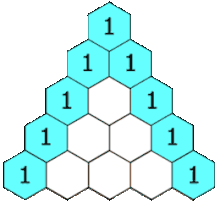 |
Each number in the triangle is the sum of the two directly above it. |
Patterns and properties
Pascal's triangle has many properties and contains many patterns of numbers.















































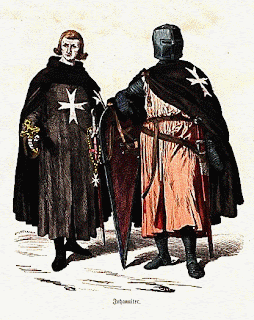








































No comments:
Post a Comment